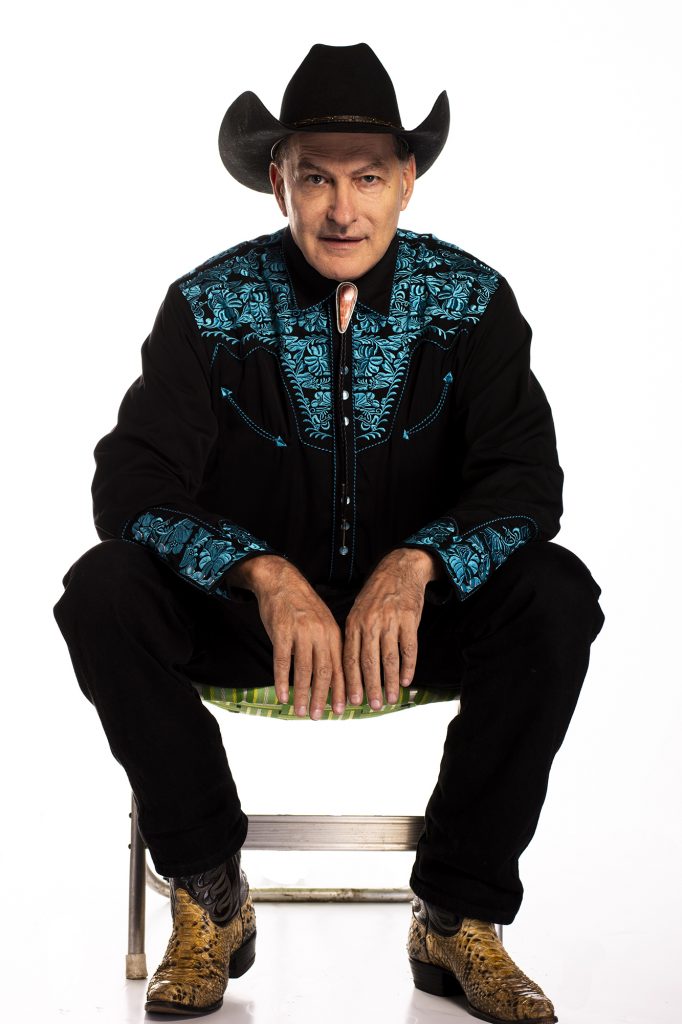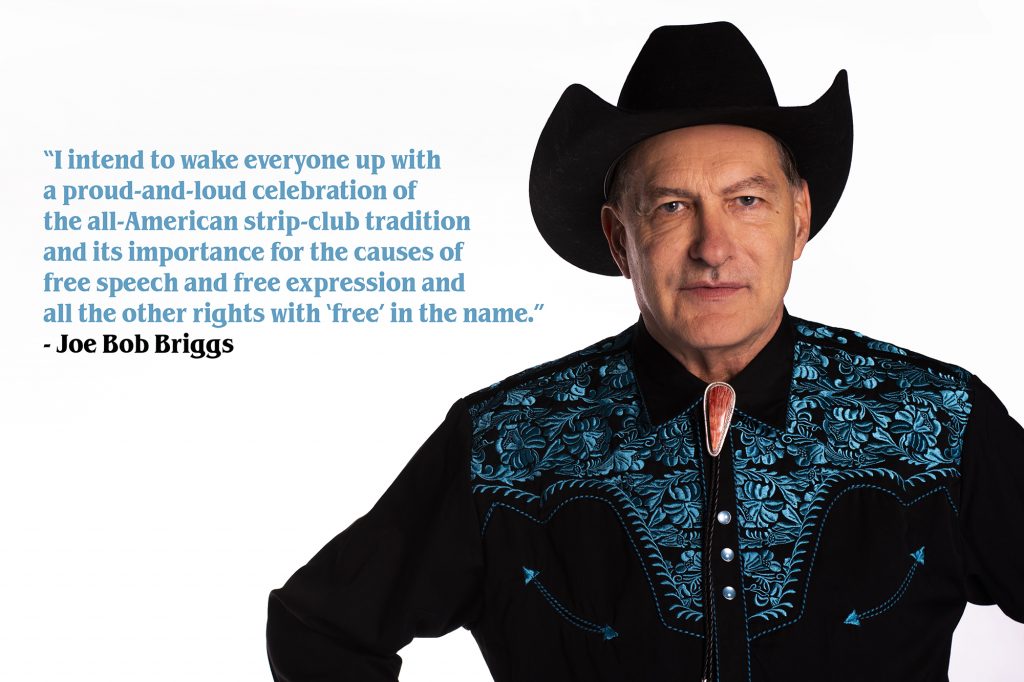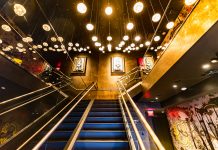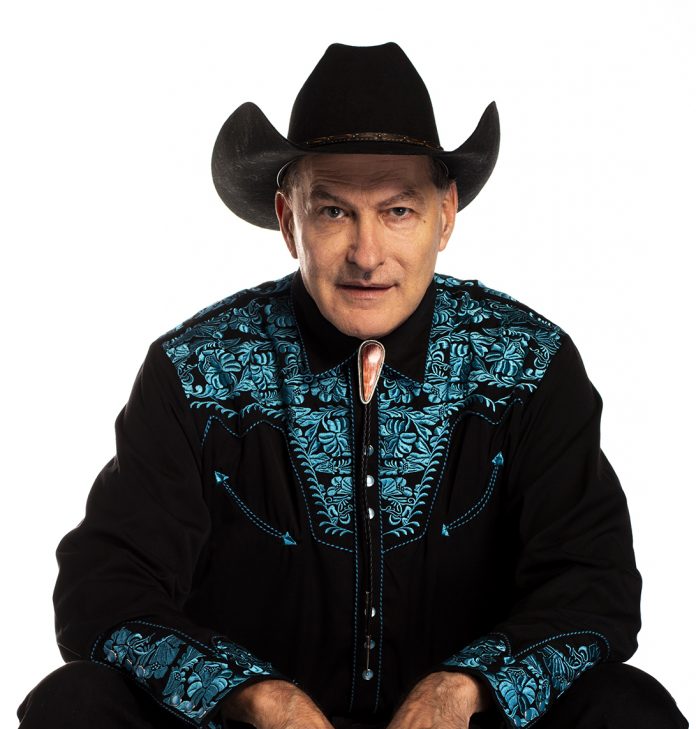Joe Bob Briggs may be best known for his career as a TV host that stretches back several decades for TNT, The Movie Channel and more recently, AMC+/Shudder, where his “The Last Drive-In” streaming show has earned hundreds of thousands of loyal followers. His work as an author has also been showcased most recently on the HBO (Max) series “Love & Death” starring Elizabeth Olsen.
But there’s much more to this Texas legend than simply his life on the boob tube. In fact, Joe Bob Briggs (real name John Bloom) is a true connoisseur of the Lone Star State’s go-go joints and burlesque bars, stretching all the way back to the 1970s. Briggs wrote about the Dallas clubs in publications such as the Dallas Observer and D Magazine, as part of his “lifetime crusade against Puritanism,” as he so eloquently puts it.
At EXPO 2024, this Texas native is going to bring his infectious charm and energy to address an industry he has long admired, written about and still celebrates to this day. In our exclusive interview with this Lone Star legend, we discuss his history with Dallas’ adult clubs, his still-flourishing TV career and what he’s most looking forward to about appearing as a Keynote Speaker at this year’s EXPO (Tuesday, August 27, 12:30-1 pm).
ED: As someone who remembers the Dallas Metroplex clubs as they evolved from the rough and tumble go-go joints of the ‘70s into the more upscale ‘gentlemen’s clubs’ of the ‘80s and ‘90s, what are your most fond recollections of that time? How did you view this ‘evolution’?
 BRIGGS: Well, a part of me misses the old biker-bar vibe of the earlier era, when it was pretty much beer-and-babes and that was it. Some of the clubs didn’t even have real sound systems, they just used jukeboxes and still had sawdust on the floor. There was a hometown feel that you don’t get in a fancy club. There were really two types of clubs prior to the seventies. In downtown Dallas, you had 12 burlesque clubs in a six-block area, but of course those featured elegant women who would strip from fabulous dresses down to G-strings and pasties. The most famous was the Colony Club, where the notorious Candy Barr headlined. Then on the various highways leading out of town, but especially on Harry Hines Boulevard, you had dive bars with the jukebox strippers. When the gentlemen’s clubs arrived, the burlesque places all shut down—but not the topless dive bars! What the gentlemen’s clubs offered, that the other clubs couldn’t, was safety and space—they were huge and they had security. The brawls that were common in the sixties—we’re talking about Texas beer joints, after all—had evaporated by the eighties as the gentleman’s clubs simply enforced rules and ejected troublemakers. Which was fine with me, because I’m not a brawler, even when I’m drunk.
BRIGGS: Well, a part of me misses the old biker-bar vibe of the earlier era, when it was pretty much beer-and-babes and that was it. Some of the clubs didn’t even have real sound systems, they just used jukeboxes and still had sawdust on the floor. There was a hometown feel that you don’t get in a fancy club. There were really two types of clubs prior to the seventies. In downtown Dallas, you had 12 burlesque clubs in a six-block area, but of course those featured elegant women who would strip from fabulous dresses down to G-strings and pasties. The most famous was the Colony Club, where the notorious Candy Barr headlined. Then on the various highways leading out of town, but especially on Harry Hines Boulevard, you had dive bars with the jukebox strippers. When the gentlemen’s clubs arrived, the burlesque places all shut down—but not the topless dive bars! What the gentlemen’s clubs offered, that the other clubs couldn’t, was safety and space—they were huge and they had security. The brawls that were common in the sixties—we’re talking about Texas beer joints, after all—had evaporated by the eighties as the gentleman’s clubs simply enforced rules and ejected troublemakers. Which was fine with me, because I’m not a brawler, even when I’m drunk.
ED: Did you have any personal favorite clubs? If so, what was it about those clubs that makes them stand out in your memory?
BRIGGS: Cabaret Royale was the first club to combine elaborate floor shows with a multiple-stage layout. Dancers performed elaborately choreographed shows—sort of updated burlesque—for three dances, then went to the smaller stages. It was actually the dancer’s choice—she could skip the show stage if she didn’t have an act. But the club had features that are common today but would have been novel at the time—a real deejay (as opposed to somebody who just screams out the name of the next dancer), table service, security, a well-lit parking lot, private dances of one sort or another, and attractive women who would sometimes fly in from as far away as London just to work three or four nights at a time.
ED: You’ve written stories throughout your career about strip clubs, including the articles you wrote for D Magazine. What initially intrigued you about writing about strip clubs? Can you think of any stories you wrote, or people that you wrote about, that are particularly memorable?
BRIGGS: I became friends with Morganna the Kissing Bandit, whose home city was Columbus, Ohio, but was arrested in Dallas for assaulting a man with her boobs. You can imagine the articles that resulted. She had nuzzled a man’s head between her breasts in the middle of a dance routine and I guess there was a cop present. Of course the incident resulted in her returning to the city many times. Every time I saw her I would say, “Careful where you point those things, you’re gonna put an eye out!” She had a great sense of humor.
I was initially intrigued by strip clubs because of my more-or-less lifetime crusade against Puritanism. These clubs are constantly fighting the establishment, trying to stay in business as moral crusaders attack them with ever more ridiculous ordinances, and what it comes down to is the crusaders just don’t like boobs! (I would say they don’t like nudity, but in most of these cases the clubs were not fully nude clubs, it was just boobs!).

ED: Strip clubs are considered on the “fringe” of speech that the First Amendment protects. Yet, they are constantly persecuted by far-right Christian groups, and endure harassment by LEOs and local officials. Why does our society appear so comfortable with violence and yet is so seemingly afraid of nudity and sexuality? Why are strip clubs so polarizing?
BRIGGS: The honest answer is that people who are miserable don’t like seeing other people having that much fun. The reason people use is that the clubs breed crime. This is completely untrue and has been disproven many times in court and through scientific studies. A strip club is one of the safest places you can be. The owners make sure of that, because they don’t want to draw attention to themselves and they certainly don’t want any criminal activity on their property.
ED: You’ve had an incredible career, and one that is certainly experiencing a new “peak” with the popularity of The Last Drive-In on Shudder and AMC-Plus. When you stopped hosting late-night TV around 2000 (I hope I have that correct), did you ever think you’d not only come back, but be as popular as you are today? Why do you think people have embraced you and The Last Drive-In so enthusiastically, to the point where you now host an entire weekend for The Last Drive-In Jamboree?
BRIGGS: Well, a lot of people have bad taste. Or I should say, they enjoy guilty pleasures, and I’ve always been the host of guilty pleasures. There’s also a kind of nostalgia for the ’80s that I don’t quite understand. The ’80s were the heyday of the slasher movie and jillions of other exploitation sub-genres and I think people miss the Wild West of movie-making. They’re sick of slick “streaming options.”
And no, I did not think I would ever be back on TV. TV rarely repeats itself. When my latest producers said “We want to do a show with you,” I said “What’s the show?” And they said, “Same show you did before.” And I said “No one will watch that, you can’t repeat TV.” And they said, “No, we want the exact same show.” And that’s what we did, only bigger. I’ve actually done the same show three times now—on The Movie Channel (“Joe Bob’s Drive-In Theater”), on TNT (“MonsterVision”) and on Shudder. That’s why the show is so weird. It’s grown organically, I’ve just added random elements as the years have passed. And it’s the only show I know of that has no time limits. It just runs until it’s over.
ED: Under your given name, John Bloom, you co-wrote the nonfiction book “Evidence of Love: The Candy Montgomery Story” (1984). The book was adapted into the CBS TV film, “A Killing in a Small Town,” and more recently the HBO Max miniseries, “Love & Death.” Is it gratifying to see a book that you co-wrote still resonating today? What did you think of “Love & Death,” in terms of how they adapted your work?
BRIGGS: It has actually been adapted for the screen three times. Barbara Hershey won an Emmy playing Candy Montgomery in the CBS movie. Jessica Biel was acclaimed for her interpretation of the role in the miniseries “Candy” for Hulu. And then HBO Max did the most faithful version of the book with “Love & Death,” with Elizabeth Olsen in the lead role. It was indeed gratifying to see the book become so popular because when it was first released, nobody cared! So yes, this has been a pleasant surprise. The book has also been translated into a couple of foreign languages and re-issued in paperback, but only because of these miniseries.
ED: You’re a Keynote Speaker at this year’s Gentlemen’s Club EXPO, the only convention in the world for the adult nightclub industry. What can our attendees look forward to about you Keynote, and what are you looking forward to about attending our convention as a special guest speaker this year?
BRIGGS: Well, the Keynote Speaker usually speaks in the morning or at lunch so I hope I’ll bring some energy and pep to a bunch of night people! I’m a night person myself so I intend to wake everyone up with a proud-and-loud celebration of the all-American strip-club tradition and its importance for the causes of free speech and free expression and all the other rights with “free” in the name. On many nights, in many parts of the country, the strip club is the best party in town, and the people who make that possible get kicked in the butt all the time, so maybe once in a while they should get some pats on the back, too. As far as what I’m looking forward to …meeting guys and gals who are so cool they own strip clubs, and maybe seeing a great stripper or two? It’s cruel to put the Keynote guy so far away from the action!
Don’t miss the Joe Bob Briggs Tuesday Keynote and the rest of our EXPO 2024 seminar lineup! We’ll see you in Dallas at the Hyatt Regency Downtown, August 25-28!





























